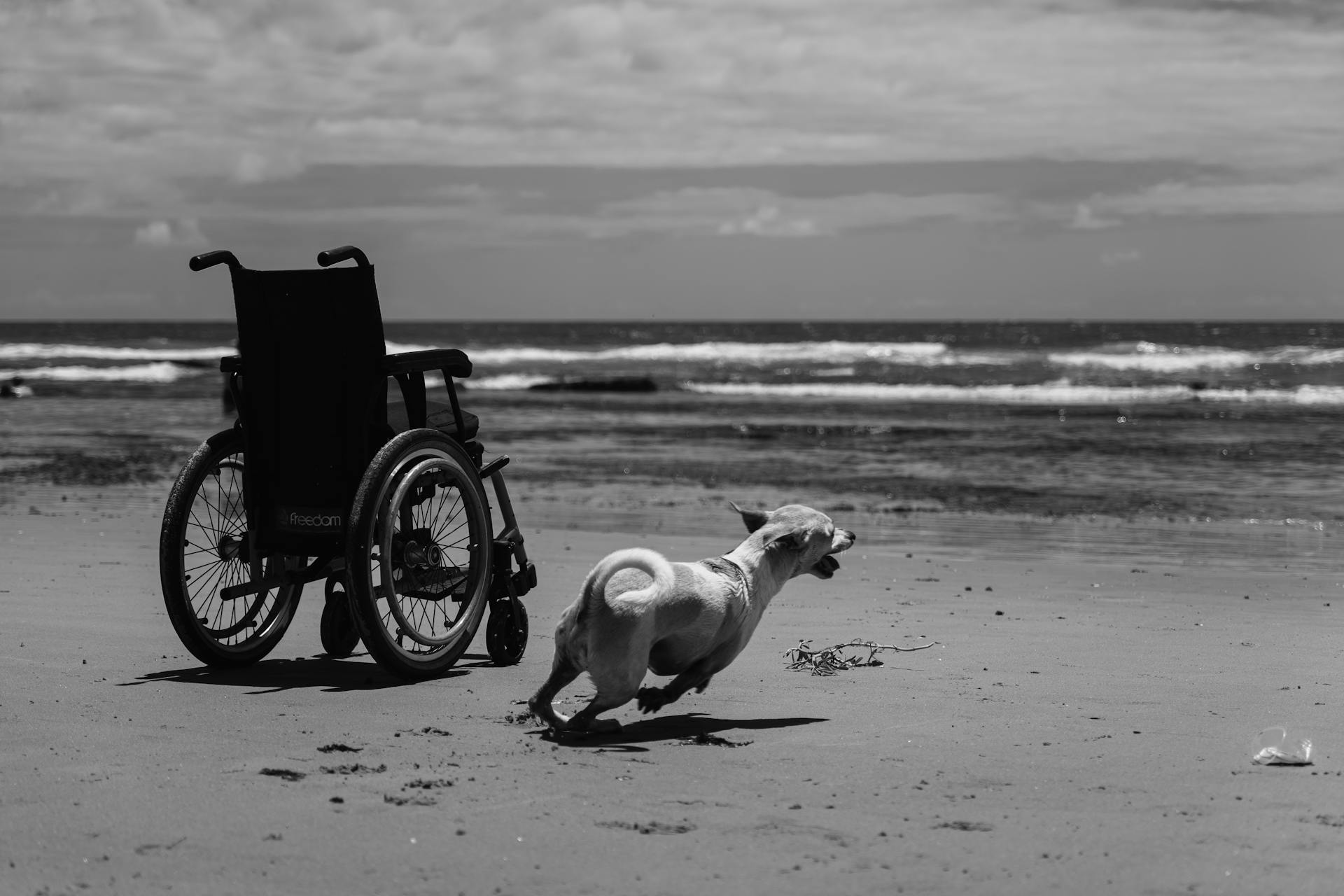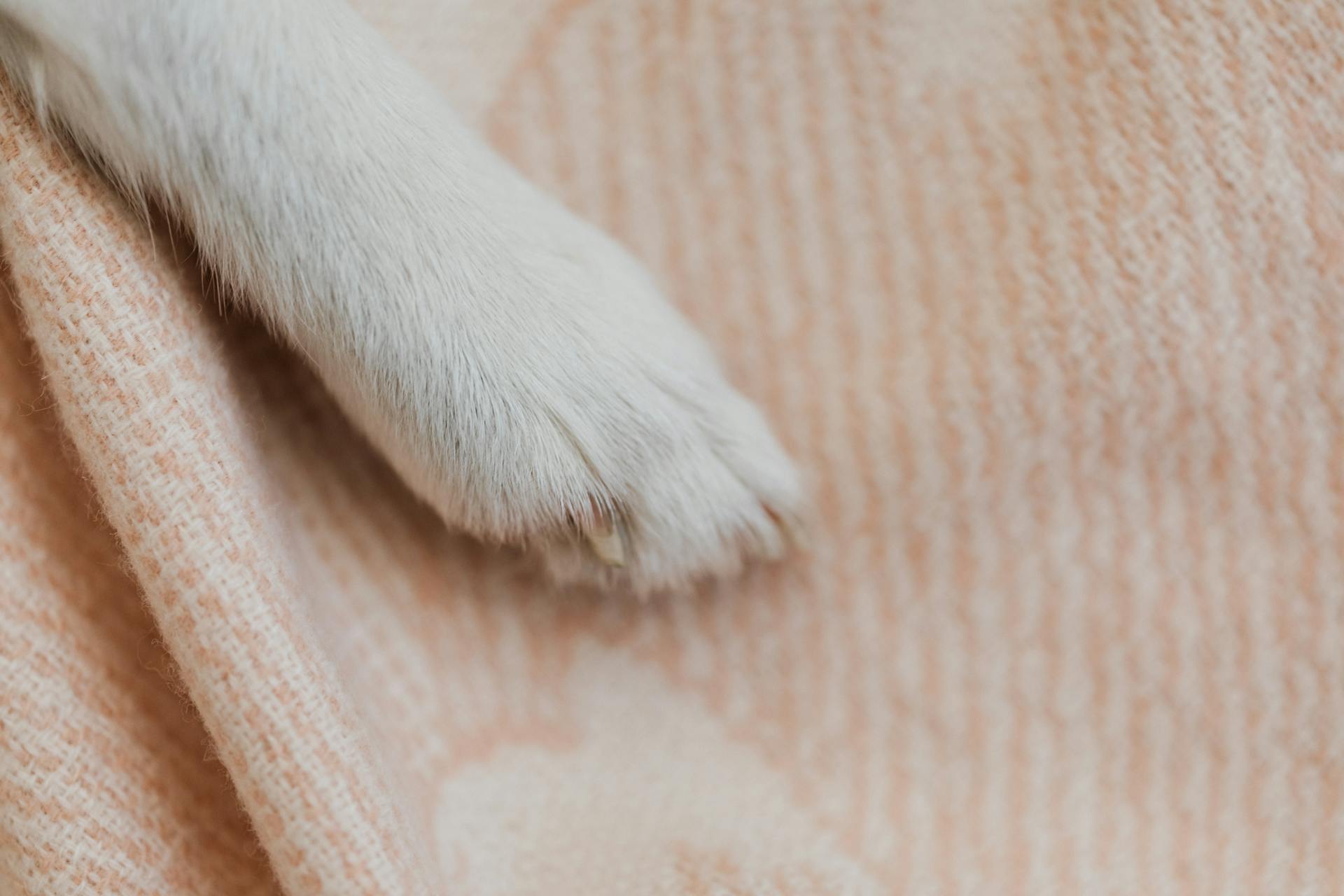
Degenerative myelopathy is a progressive and fatal disease that affects a dog's spinal cord, causing loss of coordination, balance, and eventually paralysis. It's a heartbreaking diagnosis for any dog owner.
The disease is most commonly seen in breeds such as German Shepherds, Labradors, and Australian Shepherds, and typically affects dogs between the ages of 4 and 11.
Degenerative myelopathy is caused by a genetic mutation that affects the dog's ability to produce a protein called superoxide dismutase 1, which helps protect the spinal cord from damage.
For more insights, see: Familial Renal Disease in Animals
What is Degenerative Myelopathy in Dogs?
Degenerative Myelopathy in dogs is a progressive neurological disease that affects the spinal cord, causing a breakdown of the nerve cells and their protective covering, known as the myelin sheath.
It typically starts with a loss of coordination and balance, which can lead to difficulty walking, running, and even standing.
The disease is often referred to as a canine version of Amyotrophic Lateral Sclerosis (ALS), a similar condition that affects humans.
Degenerative Myelopathy is most commonly seen in breeds such as the German Shepherd, Labrador Retriever, and Shetland Sheepdog.
The disease is caused by a genetic mutation, which can be inherited from a parent.
Symptoms can start as early as 4-6 years of age, but the average age of onset is around 8-10 years.
The disease progresses rapidly, and dogs typically live for 6-12 months after the onset of symptoms.
In the early stages, owners may notice a slight hesitation or stumbling when their dog walks or runs.
As the disease progresses, dogs may also experience muscle weakness, wasting, and paralysis of the hind legs.
Degenerative Myelopathy is a heartbreaking diagnosis, but with a genetic test, owners can now identify the disease early and make informed decisions about their dog's care.
Diagnosis and Testing
Diagnosis of degenerative myelopathy (DM) in dogs is primarily based on ruling out other diseases that cause progressive myelopathy.
To make a tentative antemortem diagnosis, veterinarians use neurodiagnostic techniques such as CSF analysis, electrodiagnostic testing, myelography, computed tomography (CT), and magnetic resonance imaging (MRI).
A presumptive diagnosis of DM is often made based on the lack of clinically relevant compressive myelopathy as determined by imaging tests like myelography, CT/myelography, or MRI.
Electrodiagnostic testing, including electromyography and nerve conduction studies, can help rule out other disorders causing neuromuscular weakness in dogs.
A definitive diagnosis of DM is determined postmortem by histopathologic examination of the spinal cord, which shows noninflammatory axonal degeneration.
A genetic test is available to check for the presence of the SOD 1 mutation, which can determine if a dog is normal, a carrier, or has two copies of the mutated gene.
Dogs with two copies of the mutated gene are at increased risk of developing DM, but may never develop the disease.
Radiographs (x-rays) may be used to evaluate the bones of the spine and hips to rule out other conditions, but the spinal cord is not visible on x-rays.
Advanced imaging tests like myelogram, computed tomography (CT), or magnetic resonance imaging (MRI) are often recommended to evaluate the spinal cord and rule out other conditions.
A neurologist may perform a physical exam and develop a list of likely causes for a dog's clinical signs, which may include spinal and joint pain, and neurologic evaluation.
Performing an orthopedic and neurologic exam, such as watching a dog walk and get up from laying down, can help distinguish neurologic issues like DM from pain and weakness from other conditions.
Expand your knowledge: Laryngeal Paralysis and Hind End Weakness
Interpreting Results
If your dog tests homozygous N/N, it means they have two normal copies of the gene, and they will never develop degenerative myelopathy (DM). This is because in the seven breeds studied, dogs with test results of N/N have never been confirmed to have DM.
Dogs that are classified as carriers, with a test result of A/N, have one mutated copy of the gene and one normal copy. They will not develop DM themselves, but they can pass the mutated gene to their offspring.
A dog that tests at-risk, or A/A, has two mutated copies of the gene and is at risk for developing DM. While not all dogs testing A/A will show clinical signs of the disease, research suggests that all dogs with confirmed DM have had A/A DNA test results.
Expand your knowledge: How Does Dog Dna Test Work
Early Signs of DM
Early signs of degenerative myelopathy (DM) in dogs can be subtle, but knowing what to look for can help you catch the disease early.
The first stage of DM affects the rear legs, causing difficulty standing up after lying down. This is often the first noticeable symptom.
Dogs with DM may also exhibit a swaying gait, where their hips move back and forth when walking or standing still. This can be a sign that the disease is progressing.
Crossing of the hind legs when walking or standing is another common symptom. It's not uncommon for one leg to be more affected than the other.
As the disease progresses, the dog's back legs may collapse or look wobbly. This can make it difficult for the dog to walk or even stand.
Here are some common early signs of DM in dogs:
- Increased difficulty standing up after lying down
- The dog’s hips swaying back and forth when walking or standing still
- Crossing of the hind legs when walking or standing
- Abnormal gait or the dog “walking funny”
- Dog’s back legs collapsing or looking wobbly
It's worth noting that these symptoms can be mistaken for other conditions, such as hip dysplasia or arthritis. However, as DM progresses, neurological changes will become more apparent, such as knuckling or folding over of the hind limbs or paws.
Risk Factors and Affected Breeds
Degenerative myelopathy (DM) is a serious condition that affects many breeds of dogs. The German Shepherd is the most common breed affected by DM, but it can also be seen in other large breed dogs like Labrador Retrievers, Boxers, and Bernese Mountain Dogs.
Dogs of certain breeds are more prone to developing DM, including German Shepherds, Siberian Huskies, Collies, Bernese Mountain Dogs, Boxers, and Golden Retrievers. These breeds should be tested for the SOD-1 mutation before breeding.
Here are some breeds that are commonly affected by DM:
- German Shepherds
- Siberian Huskies
- Collies
- Bernese Mountain
- Boxers
- Golden Retrievers
It's essential to understand which breeds develop DM so you're aware of potential health issues that could affect your pet's health in the future.
Related reading: Dog Gut Health Test
What Causes DM in Dogs?
The exact cause of DM in dogs is unknown, but research suggests that a genetic mutation, specifically the SOD-1 gene, plays a significant role in the development of the disease.
A genetic component to the disease has been identified, with dogs having two copies of a mutated superoxide dismutase 1 (SOD 1) gene being at increased risk for development of DM.
However, it's essential to note that a dog with two mutated SOD 1 genes will not necessarily go on to develop DM, indicating that other factors are involved in the development of the disease that are currently unknown.
Genetic testing can show if a patient has one or two copies of the variants associated with the development of DM, but it's still unclear whether these dogs will develop DM in the future or if there are other factors at play.
Breeds Most Affected
Degenerative Myelopathy (DM) affects various breeds of dogs, and it's essential to know which ones are most commonly affected. German Shepherds are the most common breed affected by DM.
Some breeds that commonly develop DM include German Shepherds, Siberian Huskies, and Boxers. These breeds are more likely to be affected by the genetic mutation that causes DM.
The genetic mutation that causes DM can also be seen in Bernese Mountain Dogs, Labrador Retrievers, and Chesapeake Bay Retrievers. These breeds are at a higher risk of developing DM.
Here's a list of some breeds that are commonly affected by DM:
- German Shepherds
- Siberian Huskies
- Collies
- Bernese Mountain
- Boxers
- Golden Retrievers
Dogs aged 4-14 are more likely to develop DM, so it's crucial to be aware of this risk factor if you have a dog in this age group.
Breeds Predisposed
Degenerative Myelopathy (DM) affects various breeds, but some are more predisposed to the disease than others. The German Shepherd is the most common breed affected by DM.
Several breeds are at risk, including Labrador Retrievers, Boxers, Bernese Mountain Dogs, Chesapeake Bay Retrievers, Rhodesian Ridgebacks, and Siberian Huskies. These breeds are more likely to develop DM due to their genetic makeup.
In addition to large breeds, smaller breeds like the Pembroke Welsh Corgi, Cavalier King Charles Spaniel, Pug, and Miniature Poodle are also affected. It's essential to be aware of these breeds to provide proper care and monitoring.
Here's a list of breeds that are commonly affected by DM:
- German Shepherds
- Siberian Huskies
- Labrador Retrievers
- Boxers
- Bernese Mountain Dogs
- Chesapeake Bay Retrievers
- Rhodesian Ridgebacks
- Pembroke Welsh Corgi
- Cavalier King Charles Spaniel
- Pug
- Miniature Poodle
Keep in mind that DM is often seen in middle-aged or older dogs, and there is no cure for the disease.
Diagnosis Process
A diagnosis of degenerative myelopathy (DM) in dogs is made by excluding other spinal cord diseases based on exam findings and imaging. Veterinarians will evaluate your dog for spinal and joint pain and perform a neurologic evaluation to develop a list of likely causes for your dog's clinical signs.
Several tests can be performed to rule out other potential spinal cord diseases, including a neurological exam, blood work, X-rays, MRI or CT scan, and spinal fluid analysis. Diagnostic imaging techniques, like MRI and CT, can rule out other problems that may be mistaken for DM, such as arthritis or hip dysplasia.
The spinal cord is not visible on X-rays, so advanced imaging is often necessary. A neurologist may recommend a myelogram, CT, or MRI to evaluate the spinal cord and look for compression of the spinal cord.
A definitive diagnosis of DM is determined postmortem by histopathologic examination of the spinal cord. However, a genetic test is available to check for the presence of the SOD 1 mutation, which can determine if a pet is normal, a carrier, or has two copies of the mutated gene.
Frequently Asked Questions
How much does it cost to get a dog tested for DM?
The cost of a dog Degenerative Myelopathy (DM) test is $69. Get a reliable and affordable DM test for your furry friend today.
What mimics degenerative myelopathy in dogs?
Degenerative myelopathy in dogs can be mimicked by various conditions, including peripheral nerve diseases, spinal cord disorders, and tick-borne illnesses, which can cause similar symptoms. If you suspect your dog has DM, it's essential to consult with a veterinarian to rule out these potential mimics and determine the best course of treatment.
Sources
- https://www.vravet.com/site/blog/2023/04/15/degenerative-myelopathy-dogs-symptoms-treatment
- https://www.dvm360.com/view/degenerative-myelopathy-diagnosis-and-treatment-proceedings
- https://toegrips.com/degenerative-myelopathy-in-dogs/
- https://www.petmd.com/dog/conditions/musculoskeletal/degenerative-myelopathy-dogs
- https://www.sageveterinary.com/blog/how-to-prevent-and-diagnose-dm-in-dogs
Featured Images: pexels.com


